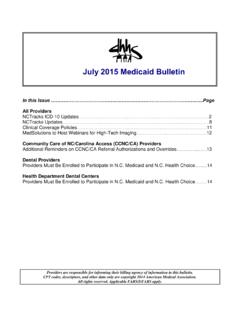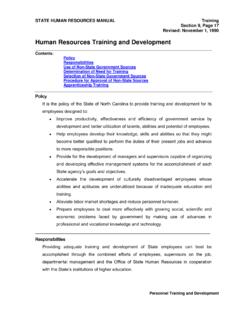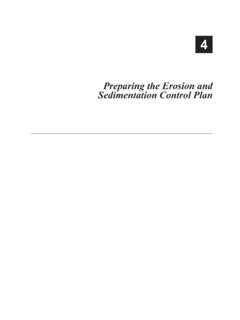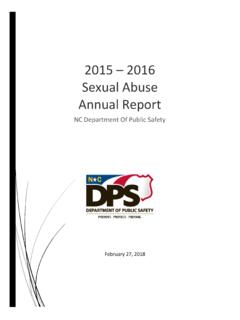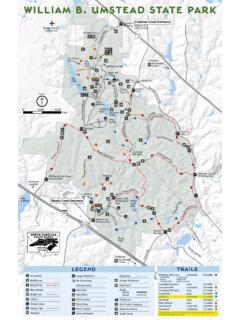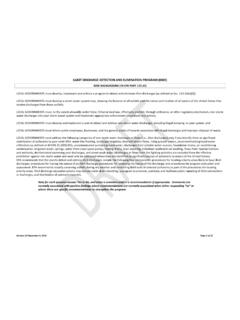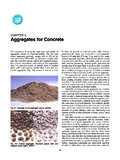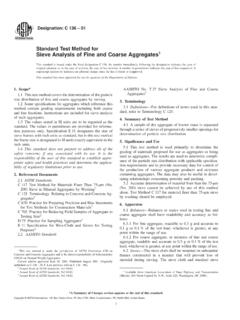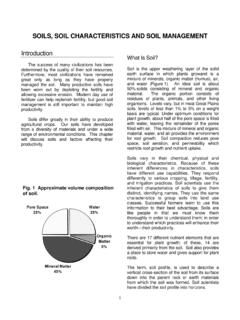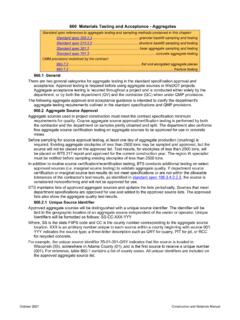Transcription of C-5. Permeable Pavement - NC
1 NCDEQ Stormwater Design Manual _____ C-5. Permeable Pavement 1 Revised: 4-6-2017 C-5. Permeable Pavement Design Objective Permeable Pavement captures stormwater through voids in the Pavement surface and filters water through an underlying aggregate reservoir. The reservoir typically allows the water to infiltrate into the soil subgrade. The reservoir can also be designed to detain and release the water to a surface conveyance system if the underlying soil is not suitable for infiltration.
2 The purpose of Permeable Pavement is to control the quality and quantity of stormwater runoff while accommodating pedestrians, parking and possibly traffic (if adequate structural support is provided). Permeable Pavement is especially useful in existing urban development where the need to expand parking areas is hindered by lack of space needed for stormwater management. Permeable Pavement is also useful in new developments with limited space where land costs are high, and when nutrient reductions or green building certification program are desired.
3 Design Volume The design volume for an infiltrating Pavement system is equivalent to the volume that is stored in the aggregate and infiltrated into the ground within a 72-hour period. The design volume for a detention Pavement system is the volume that is release slowly from the aggregate for a two to five-day period. Important Links Rule 15A NCAC 2H .1055. MDC for Permeable Pavement SCM Credit Document, C-5. Credit for Permeable Pavement NCDEQ Stormwater Design Manual _____ C-5.
4 Permeable Pavement 2 Revised: 4-6-2017 Table of Contents Built-Upon Area Credit for Infiltrating Pavement Guidance on the MDC MDC 1: Soil Investigation MDC 2: SHWT Requirements MDC 3: Siting MDC 4: Soil Subgrade Slope MDC 5: Stone Base MDC 6: Pavement Surface MDC 7: Runoff from Adjacent Areas MDC 8: Drawdown Time MDC 9: Observation Well MDC 10: Detention Systems MDC 11: Edge Restraints MDC 12: Grade When Dry MDC 13: Inspections and Certifications Recommendations Recommendation 1: Signage Recommendation 2: Geogrids, Geotextiles and Geomembranes Recommendation 3: Discussion with Owner Recommendation 4: Consider Structural Strength Construction Maintenance Old Versus New Design Standards Resources Built-upon Area Credit for Infiltrating Pavement Infiltrating Permeable Pavement that is designed per the MDC may be considered as 100% pervious for the following purposes: 1.
5 On new projects: As a tool to keep a project below the BUA threshold for high density or to reduce the volume of the SCM that is treating the balance of the project. 2. On existing projects: As a tool to add a driveway, parking area, road, patio or other paved area while still adhering to a BUA restriction imposed by development covenants, SCM design or permit conditions. The BUA credit for infiltrating Permeable Pavement cannot be used to create an exemption from the permit requirements in 15A NCAC 02H .1019(2)(c) [Coastal Stormwater Requirements], because the Permeable Pavement must be reviewed to determine whether it meets the MDC.
6 NCDEQ Stormwater Design Manual _____ C-5. Permeable Pavement 3 Revised: 4-6-2017 Figure 1. Permeable Pavement Example: Cross-Section (NCSU-BAE) Figure 2. Permeable Pavement Example: Outlet for Infiltration System (NCSU-BAE) NCDEQ Stormwater Design Manual _____ C-5. Permeable Pavement 4 Revised: 4-6-2017 Guidance on the MDC PERM EABLE PAVEM ENT MDC 1: SOI L INVEST IG ATI ON Permeable Pavement MDC 1: SOIL INVESTIGATION For infiltrating Pavement systems, site-specific soil investigation shall be performed to establish the hydraulic properties and characteristics within the proposed footprint and at the proposed elevation of the Permeable Pavement system.
7 Guidance on soil testing is provided in Chapter A-2. PERM EABLE PAVEM ENT MDC 2: SHWT REQUIR EMENT S Permeable Pavement MDC 2: SHWT REQUIREMENTS The minimum separation between the lowest point of the subgrade surface and the SHWT shall be: (a) two feet for infiltrating Pavement systems; however, the separation may be reduced to no less than one foot if the applicant provides a hydrogeologic evaluation that demonstrates that the water table will subside to its pre-storm elevation within five days or less; and (b) one foot for detention Pavement systems.
8 Guidance on soil testing and hydrogeologic evaluation is provided in Chapter A-2. PERM EABLE PAVEM ENT MDC 3: SITIN G Permeable Pavement MDC 3: SITING Permeable Pavement shall not be installed in areas where toxic pollutants are stored or handled. Permeable Pavement shall not be used in areas where concentrations of oils and grease, heavy metals and toxic chemicals are likely to be significantly higher than in typical stormwater runoff. Installing Permeable Pavement in these areas increases the risk of these pollutants entering the groundwater.
9 Examples of development types that often include stormwater hotspots are listed below. However, this is not a comprehensive list. Only the portion of the site where toxic pollutants are stored or handled is considered a hotspot. For example, the parking lot of an airport would not be a hotspot but the airplane hangar and maintenance areas are hotspots. Table 1: Hot Spots Where Permeable Pavement may not be Appropriate Fueling facilities SIC code heavy industries Commercial car washes Fleet storage Airport maintenance areas Public works yards Trucking & distribution centers Wastewater treatment plants Road maintenance areas Vehicle maintenance areas Racetracks Scrap yards Solid waste facilities Railroads and bulk shipping Landfills NCDEQ Stormwater Design Manual _____ C-5.
10 Permeable Pavement 5 Revised: 4-6-2017 Care should be taken when implementing Permeable Pavement at redevelopment sites. Stormwater shall not be infiltrated into contaminated soils because this can cause dispersion of toxic substances to other sites and to groundwater. However, a Permeable Pavement system designed for detention may work on a contaminated site. If the site history includes land uses listed above, it shall be assumed that contaminated soils are present until detailed investigation determines otherwise.

